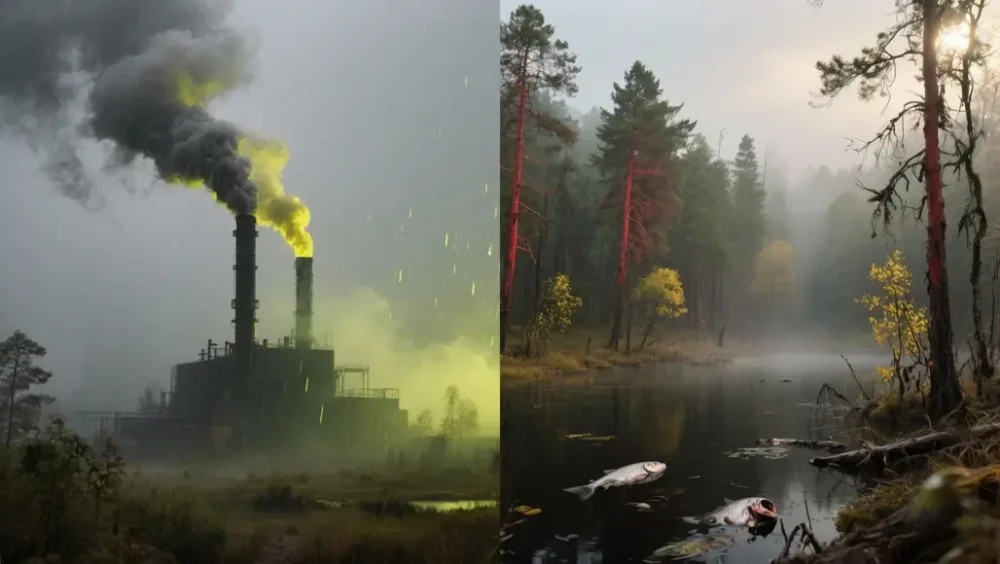You know that sharp smell when you strike a match? That’s sulfur dioxide, and while most of us only encounter it in tiny whiffs, this gas has been reshaping our environment for decades. The good news? We’ve made incredible progress. The bad news? There’s still work to do.
What sulfur dioxide actually does to our world
Sulfur dioxide, scientists call it SO₂, wreaks havoc in three main ways. First, it creates acid rain that’s been killing fish and trees for decades. Second, it forms that gray smog you see hanging over cities. Third, it messes with our lungs and hearts in ways researchers are still uncovering.
Here’s something encouraging though: since 1990, the U.S. has cut its SO₂ emissions by 92%. That’s massive. But globally, we’re not out of the woods yet.
Where this stuff comes from
Most sulfur dioxide, somewhere between 70-75% of it, comes from us. Coal-fired power plants are the biggest culprits, responsible for about half of all human-caused emissions. Metal smelting plants are another major source, along with ships burning high-sulfur fuel.
Nature contributes too. Volcanoes belch out 20-25 million tons every year, and believe it or not, tiny ocean organisms produce compounds that eventually become SO₂. But in cities, it’s almost all on us; over 95% comes from burning coal and other fuels.
The acid rain problem is worse than you think
When SO₂ hits the atmosphere, it doesn’t just disappear. Through a series of chemical reactions, it becomes sulfuric acid the main ingredient in acid rain. We’re talking about rain with a pH as low as 4.0, which is somewhere between tomato juice and stomach acid. Normal rain? That sits around 5.6.
What happens to lakes and rivers
In New York’s Adirondack region, researchers found that nearly a quarter of surveyed lakes had become too acidic to support most aquatic life. Get this: 346 lakes had absolutely no fish in them. Zero.
The problem goes beyond just acidity. When pH drops below 5, aluminum leaches out of the surrounding soil and accumulates in the water at toxic levels. This aluminum doesn’t just irritate fish, it disrupts the salt balance in their blood, ruptures their red blood cells, and can cause fatal heart problems. Fish eggs won’t even hatch below pH 5, which means entire generations never get a chance.
The damage ripples through the whole ecosystem. Mayflies and other sensitive invertebrates start dying off around pH 5.5, and suddenly the fish don’t have anything to eat—even before the water gets acidic enough to kill them directly.
Forests are dying too
Back in the 1980s and 90s, European forests experienced something called “waldsterben”, literally “forest death” in German. Nearly a quarter of surveyed trees showed serious damage from air pollution. In the Adirondacks and Green Mountains of North America, more than half of the large red spruce trees died.
The way acid rain kills trees is actually pretty insidious. It strips away essential nutrients like calcium and magnesium from the soil. At Hubbard Brook in New Hampshire, scientists watched over half the available calcium vanish over 70 years. Meanwhile, the acidification releases aluminum that attacks tree roots, essentially “pruning” them so they can’t absorb water or nutrients anymore.
Here’s the really frustrating part: even after we clean up the air, forest soils take centuries to recover naturally. The damage we’ve done will outlive all of us.
Air quality and that gray haze
SO₂ doesn’t stay as a gas forever. It oxidizes into tiny sulfate particles that create smog and reduce visibility. If you’ve ever looked at the Great Smoky Mountains and wondered why they weren’t very clear, sulfur pollution was likely part of the problem.
The silver lining? As we’ve cut emissions, skies have actually gotten clearer. You can see it with your own eyes in places that have implemented strong pollution controls.
Your lungs don’t like sulfur dioxide
Globally, air pollution contributes to about 4.2 million early deaths every year, and SO₂ is part of that equation. The effects range from immediate breathing problems to long-term damage you might not notice until years later.
What happens right away
Breathe in sulfur dioxide and you’ll know it. The gas dissolves in the moisture of your eyes, nose, throat, and lungs to form acid. This causes:
- Coughing and sneezing fits
- Your chest feels tight
- You wheeze when breathing
- Your airways burn
- Your eyes sting and water
About 90-95% of SO₂ gets absorbed in your nasal passages and upper airways at high concentrations, where it immediately forms sulfurous acid and causes irritation.
The asthma connection is scary
If you have asthma, sulfur dioxide is particularly dangerous. Within seconds, literally seconds of exposure, it can trigger your airways to narrow, making it hard to breathe.
Asthmatics start having symptoms at concentrations as low as 0.1-0.25 parts per million, especially during exercise. At 0.5 ppm, many people need their rescue inhalers. Studies have documented lung function dropping by 23% at 1 ppm during exercise.
Why does exercise make things worse? Simple, when you’re working out, you’re gulping down air faster and pulling it deeper into your lungs. That gives SO₂ more opportunities to reach places it shouldn’t.
The damage that builds over time
If you’re constantly breathing this stuff, your body starts breaking down in ways that aren’t immediately obvious. You might develop chronic bronchitis. Your lungs gradually lose their ability to work properly. You catch respiratory infections more easily.
A 2024 study put some hard numbers on this. For every 10 µg/m³ bump in SO₂ levels, overall death rates went up by about 0.5-0.7%. Deaths specifically from breathing problems jumped even higher, up to 1%.
But here’s where it gets really wild. Scientists have discovered that SO₂ doesn’t just mess with your lungs it attacks your heart too. Specifically, it damages the mitochondria inside heart muscle cells. Think of mitochondria as tiny power generators keeping your cells running. When they malfunction, your heart can’t pump properly. That’s a direct path to heart failure and dangerous irregular rhythms.
Who’s most at risk?
Not everyone reacts to SO₂ the same way. Some folks are sitting ducks:
People with existing lung problems feel it even when concentrations are relatively low. Their bodies just can’t handle any extra stress on the respiratory system.
Children get hit harder for three reasons: their lungs aren’t finished growing yet, they naturally breathe faster than adults, and they’re outside playing way more often. Kids don’t get to choose whether they’re exposed.
Older adults usually come to the table with existing heart or lung issues. SO₂ doesn’t create these problems out of nowhere it makes whatever’s already there significantly worse.
Athletes and fitness enthusiasts face a paradox. You’re trying to be healthy by exercising, but you’re also sucking in more air and whatever pollutants are in it with every breath.
So what’s actually dangerous?
The EPA drew a line in the sand at 75 ppb for a one-hour maximum. The World Health Organization recommends keeping 24-hour averages below 40 µg/m³ (roughly 15 ppb).
Here’s the thing though: most people can smell SO₂ around 500 ppb. By the time you catch that burnt-match odor, you’re already breathing concentrations high enough to cause problems.
The air quality index explained
Before you head out for a jog or plan that picnic, check real-time air quality data including SO₂ levels, pull up AirNow.gov, or grab the Ambee app. Here’s what those color codes actually mean:
| AQI level | SO₂ concentration | What it means for you |
| Good (Green) | 0-35 ppb | Everything’s fine get outside and enjoy it |
| Moderate (Yellow) | 35-75 ppb | If you’re sensitive to air pollution, maybe don’t overdo it |
| Unhealthy for sensitive groups (Orange) | 75-185 ppb | Kids running around outside, active adults, anyone with lung issues time to dial it back |
| Unhealthy (Red) | 185-304 ppb | If you’re in a sensitive group, seriously consider skipping outdoor workouts |
| Very unhealthy (Purple) | 304-604 ppb | Sensitive groups: stay inside, period |
| Hazardous (Maroon) | 604-1004 ppb | Nobody should be exercising outside at these levels |
Here’s something that might bother you: scientists haven’t found a level where SO₂ is completely harmless. Even tiny amounts seem to cause some health effects. Sure, the risk to you personally at low levels is minimal, but when you’re talking about entire populations millions of people those tiny risks start adding up to real health problems.
One of environmentalism’s biggest wins
This is actually the hopeful part. When it comes to sulfur dioxide, we’ve pulled off something remarkable.
Look at these numbers:
- American power plants? They’ve slashed emissions by 95% since 1995.
- China cut its by three-quarters between 2007 and 2017 and they were burning 50% MORE coal during that time.
- The UK has dropped emissions by 97% since 1990.
- Big EU power plants reduced SO₂ by 94% from 2004 to 2023.
- Even the shipping industry got its act together, cutting emissions by 80% with cleaner fuel rules.
- This demolishes the myth that you have to choose between a healthy economy and clean air. You can have both.
The tools that actually made a difference
Those big scrubbers on smokestacks? They work incredibly well 90-99% removal rates. There are over 850 of them running at 250 coal plants across the U.S. The clever part? They don’t just trap SO₂, they turn it into gypsum. You know, the stuff in drywall. One industry’s waste becomes another industry’s product.
Fuel regulations were huge. Making diesel and gasoline cleaner helped a lot. And in 2020, the International Maritime Organization forced ships to drop their fuel sulfur content from 3.5% down to 0.5%. The Mediterranean is pushing it even lower 0.1% by 2025.
Policy frameworks like the Clean Air Act’s Acid Rain Program used cap-and-trade systems that actually worked. The EU Industrial Emissions Directive did similar heavy lifting in Europe.
Renewables are the long-term answer. Wind turbines and solar panels produce zero SO₂ while generating electricity. Last year, renewables made up half of the EU’s electricity. The IMF crunched the numbers and found that ditching coal for renewables could create $78 trillion in benefits globally. Yeah, trillion with a T.
What can you actually do about this?
Look after your own health first
Check air quality before you head outside. Monitor real-time SO₂ and other pollutant levels in your area, use aqi.getambee.com, and the Ambee app gives you real-time updates.
If you’ve got asthma or similar issues, start paying attention when SO₂ hits 50 ppb. At 75 ppb, maybe skip the outdoor run. Above 100 ppb? Just stay inside.
Always keep your rescue inhaler within reach. Close your windows when pollution spikes. An indoor air quality monitoring system isn’t a bad investment either—it helps you track SO₂ and other pollutants inside your home when outdoor pollution infiltrates through windows and ventilation.
Cut down your own contribution
Power plants generate 73% of America’s SO₂, which means your electricity habits matter more than you’d think.
The easy wins: LED bulbs use 75% less power. ENERGY STAR appliances make a difference. Better insulation keeps your heating and cooling inside where it belongs. Programmable thermostats stop you from heating an empty house. And seriously, unplug stuff you’re not using it’s pulling power even when “off.”
If you can swing it, look into rooftop solar or switch to a green energy plan from your utility. Even community solar programs let you get in on renewable energy without installing anything. For transportation, use public transit when you can, carpool, bike, or walk. Electric and hybrid vehicles help too.
Push for better policy
Individual actions matter, but policy is what really moves the needle. The success story of SO₂ reduction happened because citizens demanded change and legislators responded.
Vote for candidates who prioritize clean air. Contact your representatives about emission controls. Show up to community meetings when local industrial permits are up for discussion. Support businesses committed to clean energy. Share what you know about SO₂ with people in your community.
What’s left to do
Despite amazing progress, challenges remain. India emits 11.2 million metric tons annually about 16% of global emissions. Developing regions still depend heavily on high-sulfur coal with minimal controls. And remember, even after emissions stop, ecosystems need decades or centuries to recover.
We need to deploy the most efficient scrubbers on remaining coal facilities, accelerate the renewable energy transition, implement stricter standards like the EPA’s December 2024 secondary standard of 10 ppb annual average, help developing nations adopt clean technologies with better air quality APIs, and maintain vigilant monitoring and enforcement.
The bottom line
The sulfur dioxide story teaches us something powerful: when people noticed dying fish, damaged forests, and widespread respiratory illness, they figured out solutions and implemented them. And it actually worked.
Skies that once carried devastating loads of SO₂ now show clear blue in many regions. Lakes that were dead are coming back to life. Forests are slowly healing. Respiratory emergency visits have declined where strong controls exist.
But billions still breathe unhealthy air. Ecosystems still bear the scars of acid rain. We’ve got the science. We’ve got the technology. We’ve got policies that have already proven they work. What’s missing? Rolling this stuff out everywhere, fast enough to actually finish what we started.
You don’t win the clean air fight once and call it done. It’s more like maintaining a garden constant attention, ongoing work. When you understand what SO₂ does to our world, you can help protect the gains we’ve fought for and push to extend them to the billions who still can’t breathe clean air.
Yeah, the pollutant is invisible. But what we do about it doesn’t have to be. Here’s to skies you can actually see through, ecosystems that thrive instead of just survive, and a planet that doesn’t actively poison its inhabitants.



